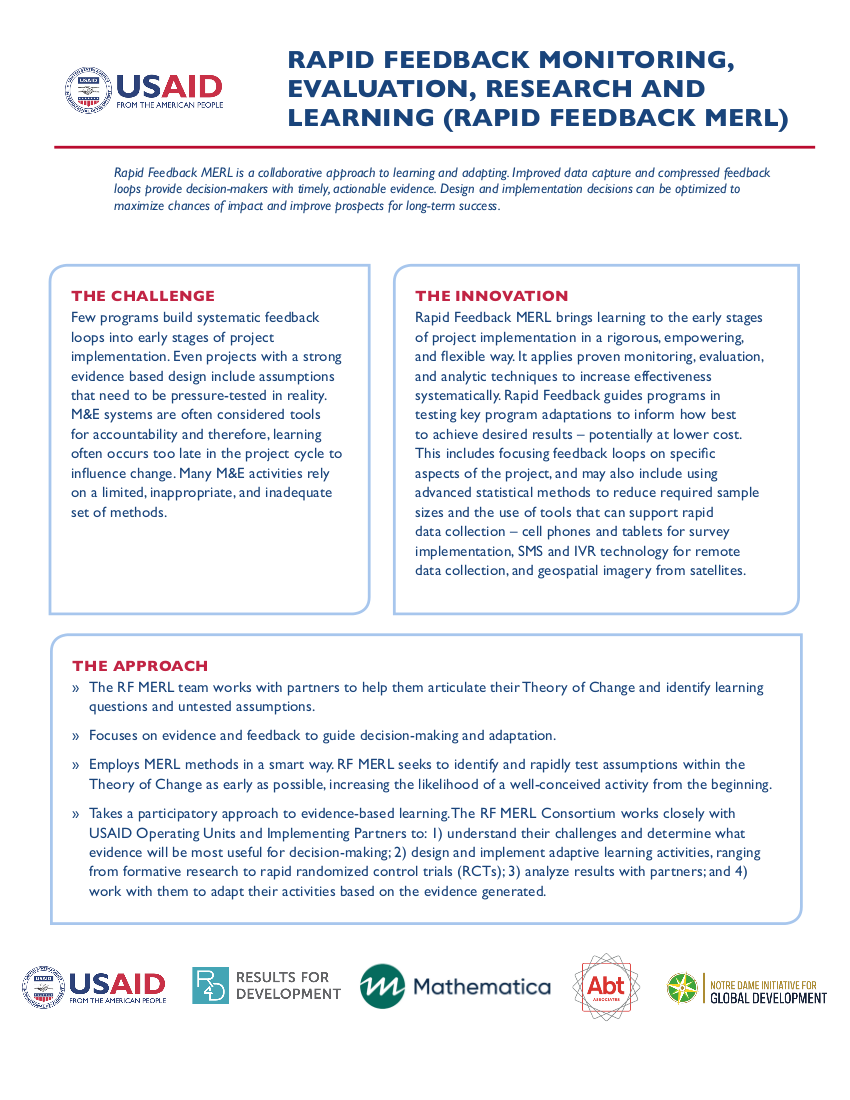- What We Do
- Agriculture and Food Security
- Democracy, Human Rights and Governance
- Economic Growth and Trade
- Education
- Environment and Global Climate Change
- Gender Equality and Women's Empowerment
- Global Health
- Humanitarian Assistance
- Transformation at USAID
- Water and Sanitation
- Working in Crises and Conflict
- U.S. Global Development Lab
Speeches Shim
Rapid Feedback MERL is a collaborative approach to learning and adapting. Improved data capture and compressed feedback loops provide decision-makers with timely, actionable evidence. Design and implementation decisions can be optimized to maximize chances of impact and improve prospects for long-term success.
The Challenge
Few programs build systematic feedback loops into early stages of project implementation. Even projects with a strong evidence based design include assumptions that need to be pressure-tested in reality. M&E systems are often considered tools for accountability and therefore, learning often occurs too late in the project cycle to influence change. Many M&E activities rely on a limited, inappropriate, and inadequate set of methods.
The Innovation
Rapid Feedback MERL brings learning to the early stages of project implementation in a rigorous, empowering, and flexible way. It applies proven monitoring, evaluation, and analytic techniques to increase effectiveness systematically. Rapid Feedback guides programs in testing key program adaptations to inform how best to achieve desired results – potentially at lower cost. This includes focusing feedback loops on specific aspects of the project, and may also include using advanced statistical methods to reduce required sample sizes and the use of tools that can support rapid data collection – cell phones and tablets for survey implementation, SMS and IVR technology for remote data collection, and geospatial imagery from satellites.
The Approach
Rapid Feedback MERL brings learning to the early stages of project implementation in a rigorous, empowering, and flexible way. It applies proven monitoring, evaluation, and analytic techniques to increase effectiveness systematically. Rapid Feedback guides programs in testing key program adaptations to inform how best to achieve desired results – potentially at lower cost. This includes focusing feedback loops on specific aspects of the project, and may also include using advanced statistical methods to reduce required sample sizes and the use of tools that can support rapid data collection – cell phones and tablets for survey implementation, SMS and IVR technology for remote data collection, and geospatial imagery from satellites.
Quick Facts
- Tools (illustrative): Tools will match the design questions to support timely decision making, but may include focus groups, RCTs, quasiexperimental designs, and in some cases factorial orthogonal design
- Funding mechanism: Cooperative Agreement (buy-in option for USAID operating units)
- Partners: Results for Development Institute (prime), Abt Associates Inc., Mathematica Policy Research, Notre Dame Initiative for Global Development
- Period of Performance: 10/01/2015 – 9/30/2024
Lab Contact: Sophia van der Bijl, svanderbijl@usaid.gov


Comment
Make a general inquiry or suggest an improvement.